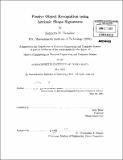Passive object recognition using intrinsic shape signatures
Author(s)
Donahue, Kenneth M. (Kenneth Michael)
DownloadFull printable version (4.708Mb)
Other Contributors
Massachusetts Institute of Technology. Dept. of Electrical Engineering and Computer Science.
Advisor
Seth Teller.
Terms of use
Metadata
Show full item recordAbstract
The Agile Robotics Group (AR) at MIT's Computer Science and Artificial Intelligence Laboratories (CSAIL) has an autonomous, forklift capable of doing task planning, navigation, obstacle detection and avoidance, focused object detection, etc. The goal of the project is to have a completely autonomous robot that is safe to use in a human environment. One aspect of the project which would be very beneficial to moving on to more complicated tasks is passive object recognition. The forklift is capable of doing a focused scan and looking for very particular things. The forklift is constantly scanning its vicinity with its Light Detection and Ranging (LiDAR) sensors to ensure that it avoids obstacles; instead of only using that information for hazard avoidance, that information can be used to not only passively notice objects but also classify them. This will be useful later when the team starts implementing various higher-level processes, such as localization and/or mapping. This paper will discuss various modules that were integrated into the Agile Robotics infrastructure that made object recognition possible. These modules were 1) a data segmentation module, 2) an object recognition module using Intrinsic Shape Signature[10] (ISS) to find feature points in our LiDAR data, and 3) various visualization modules to ensure that each module was behaving properly.
Description
Thesis (M. Eng.)--Massachusetts Institute of Technology, Dept. of Electrical Engineering and Computer Science, 2011. Cataloged from PDF version of thesis. Includes bibliographical references (p. 53).
Date issued
2011Department
Massachusetts Institute of Technology. Department of Electrical Engineering and Computer SciencePublisher
Massachusetts Institute of Technology
Keywords
Electrical Engineering and Computer Science.